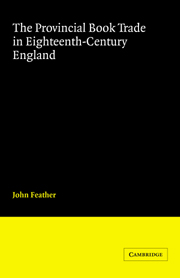Book contents
- Frontmatter
- Contents
- List of Illustrations
- Preface
- Acknowledgements
- Note on Sources
- Note on Dates and Places
- Abbreviations
- Chapter 1 London and the Country
- Chapter 2 A Century of Growth
- Chapter 3 The Market for Books
- Chapter 4 The Distribution System
- Chapter 5 The Bookselling Business
- Chapter 6 The Printing Office
- Conclusion
- Appendix I Ellen Feepound's Book Stock
- Appendix II William Seale's Paper Stock
- Appendix III John Cheney's Printing Equipment
- Appendix IV The Universal British Directory
- Appendix V Subscribers to Thomas Hervey's The Writer's Time Redeemed
- Appendix VI Subscribers to Elisha Coles's Practical Discourse
- Appendix VII Subscribers to Job Orton's Short and Plain Exposition
- Notes
- Index of the Provincial Book Trade
- General Index
Chapter 6 - The Printing Office
Published online by Cambridge University Press: 04 August 2010
- Frontmatter
- Contents
- List of Illustrations
- Preface
- Acknowledgements
- Note on Sources
- Note on Dates and Places
- Abbreviations
- Chapter 1 London and the Country
- Chapter 2 A Century of Growth
- Chapter 3 The Market for Books
- Chapter 4 The Distribution System
- Chapter 5 The Bookselling Business
- Chapter 6 The Printing Office
- Conclusion
- Appendix I Ellen Feepound's Book Stock
- Appendix II William Seale's Paper Stock
- Appendix III John Cheney's Printing Equipment
- Appendix IV The Universal British Directory
- Appendix V Subscribers to Thomas Hervey's The Writer's Time Redeemed
- Appendix VI Subscribers to Elisha Coles's Practical Discourse
- Appendix VII Subscribers to Job Orton's Short and Plain Exposition
- Notes
- Index of the Provincial Book Trade
- General Index
Summary
In 1733 Thomas Gent was generous to his nephew, Arthur Clarke. He set him up in business in the popular resort of Scarborough on the Yorkshire coast, where he was the first printer. Clarke's shop became something of a tourist attraction: ‘The gentry from the Spa used to visit us, to have their names, and see the playhouse bills and other work printed.’ Clarke's printing house was not alone in receiving such attention. While presses were still unusual in the provinces they were often visited by the curious. Nicholas Blundell of Little Crosby, Lancashire, recorded in his diary for 5 July 1712 that he had visited Samuel Terry's printing house when he was in nearby Liverpool. Terry was the first Liverpool printer, and had been in business for only a few weeks; the first issue of his Leverpoole Courant had probably appeared on 12 May. Later in the century, the printing trade was sufficiently widespread to be less interesting, and as we have seen by about 1770 there were few towns of any size without at least one printer. The activities of these printers were very varied: some produced newspapers, some produced books, all did jobbing work, and most of them were also booksellers and stationers. The key role of the newspaper printers in the trade has already been discussed at some length, but in this chapter we shall open the door to the printing office itself. What equipment and materials were to be found there? How many men were at work? What were the costs, charges, and profits of the provincial printer? What did he print, and how did he sell it?
- Type
- Chapter
- Information
- The Provincial Book Trade in Eighteenth-Century England , pp. 98 - 122Publisher: Cambridge University PressPrint publication year: 1985

